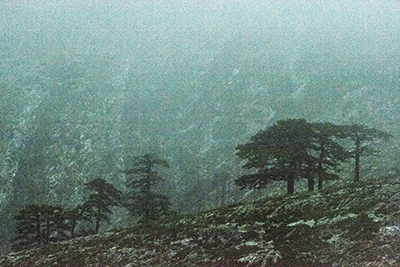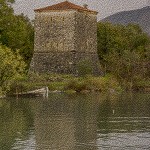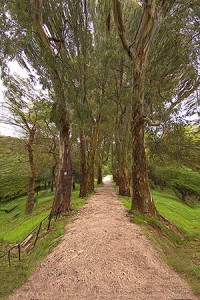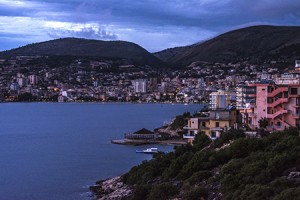Traveling With History...Albania
Unexpected surprises in a once closed land.
Looking to add something exotic to an upcoming trip to Switzerland, I set out for Albania. Separated by politics as a Maoist ally of communist China,

The equestrian statue of national hero, Skanderbeg, graces the center of Skanderbeg Square. The moon rises over the adjacent, 18th-century Et`hem Bey mosque and the landmark Clock Tower.The National Museum (a must see), Opera House and government offices also face the square.
its long history of isolation is bred of mountainous terrain and a will for independence. With Italy a mere 160 miles to the west, across the Adriatic, it had been incorporated into the Roman empire by 145. Greece is even closer at hand. The town of Sarande is only a few miles from the Greek island of Corfu, reached by ferry and hydrofoil.
It is mountains even more than the sea that define Albania. The valleys they create provide land for agriculture, with sloping hillsides planted in olives and pasture for goats and sheep, with sheep-herding still a traditional occupation in the rural south.
Five centuries of Turkish rule have left their mark on the people and the land. Music, dress, architecture, and religion were all Ottoman imports.

The walls of Berati date back seven centuries. They enclose what remains of a once thriving fortified town, that is still home to a small number of families, with panoramic views on all sides.
Hillsides were fortified to assure control of the valleys below. Towns like Berati and Gjirokastra preserve their fortifications and are UNESCO World Heritage sites.
I found nothing of the sort, never felt-threatened in any way. I found people focused on the rewards of freedom and the promise of greater prosperity beginning to take hold.
Family still defines things. “I will soon be getting married,” a 30-year-old waiter in Tirana told me. “My father is now adding a floor to his house that will belong to us.. My brother and his family already live there. This is very common in Albania.”
Iconostasis in the Onufri Museum in Berati. While Islam is the majority religion, pockets of Christians are found in the south near Greece and in the north near Serbia.
Islam, largely disempowered by decades of communist rule, has also separated Albania from its Christian neighbors, with Greek Orthodox to the south, Serbian Orthodox to the east, and Catholic Italy to the west. As part of the Ottoman Empire, with an influx of Muslim settlers, many Christian Albanians converted to Islam in the early Middle Ages. But Christian communities remained, with an obvious presence as we traveled south, driving through a landscape of steep hills radiating the blue-green of olive trees and the lovely sound of bells ringing from the necks of the sheep and goats that link southern Albania to Macedonia and Greece.
Driving in Albania provided some challenge, with roads only intermittently surfaced or smooth> That provided a challenge I enjoy, which was amplified on our last full day on a 6-hour-long drive along that's called the Albanian Riviera, a stretch about 60 miles of spectacular coastal mountains north of Sarande.
Not everyone has a car, and there are still cattle-drawn carts in the countryside, and even in Tirana. But change is in evidence everywhere, from stylish fashions in Tirana's shops to house construction in burgeoning Tirana and vicinity. Most are only partly finished, lower floors topped by tall concrete posts designed to additional floors when resources permit. Transportation infrastructure has only been marginally addressed by a cash-poor government.
My on-line choice of the centrally located Hotel Areela... small, but with full modern amenities, proved a perfect base in Tirana, a family-run hotel with warm, welcoming and helpful proprietors. Grown to more than a million people, Tirana lies at the foot of mountains that are already snow-covered on my mid-November visit.
In terms of weather, November certainly wasn’t the best time of year to go, with heavy rains interfering with driving and touring. Other days were blue-sky clear and scenic. Summer brings a flood of visitors, the majority crossing the Adriatic by car ferry from Brindisi or flying in from Rome. “There are more Italian restaurant than Albanian restaurants, our taxi driver remarked
when we asked him to recommend a restaurant featuring traditional Albanian food. Luckily we tracked some down in Tirana and Gjirokastra, where chef Defrim Gjoca prepared qilfi (eggs, rice, and cheese),
specate mbushura medjath (stuffed peppers with cheese), and a deliciously abudant mix of greens and goat feta. Fresh ingredients, fabulously tasty, washed down with a cold bottle of Korca, a refreshing local beer.
Italy’s links to Albania start in Roman times, with lands now part of Albania were part of the province of Macedonia. When the Roman Empire split, Albania became part of the Byzantine Empire until 1453 when it was overrun by the Ottoman Turks. Under Mussolini, Albania was annexed as a part of Italy in 1939, following a failed attempt at annexation of south Albania in 1920.
Zog, the Albanian king, fled to Greece, and Italy’s Victor Emanuelle III, was named King of Albania. That forced union
ended in 1944, when communist partisans secured control of the country. For the next 56 years it was Allied with the Stalinist Soviet Union and then Maoist China.
Albania offers bargain pricing on hotels and dining, It’s hard to spend $30, for two, at dinner and easy spend a lot less on lamb, pork, chicken, and deliciously fresh vegetables on the menu. Breakfast at our Tirana hotel was an elaborate offering of bread, eggs, ham, fruit, juice, cheese, coffee and more, included in the $39 nightly room rate, pricing matched elsewhere on our
travels. Rental cars are easy to find, we booked a comfortable and road-worthy Volkswagen that proved adequate to Albania’s notoriously rough roads. Gas was the budget exception, priced at more than $8/gallon, but driving allowed full access to the scenic southeast quarter of the country.
*****
Albania makes a great getaway from tourist-clogged Europe, an easy-to-reach alternative (it’s a 75-minute, $95 flight from Rome) alternative, with plenty to do to stay busy for a week or two, if you want to add northern Albania to the itinerary.
The Albanians proved to be open to outsiders, friendly and helpful when the need arises, that fact proven on a cold, dark night in Gjirokasta, when what appeared to be a road, proved to be a ditch, leaving the right front wheel spinning free over the inky black of a five foot deep ditch, with a stone wall mere inches from the rear of the car.
A knock on the door of a nearby house brought a call to three men who spent well over an hour, determined to free us from a very challenging problem that would have been made even worse by the rainy weather that followed the next morning. No one was home the next morning
when I returned with gifts, including macadamia nuts from Hawaii, likely an unknown taste treat.
The Basics
Travel: No visa required, passport stamped upon entry. The lek is the currency. It trades at about 100 to the dollar, which makes pricing simple. High fashion isn’t the thing here, unless you’re a bride, with wedding shops as ubiquitous as nail salons in the U.S. In some places dollars and Euro are accepted.
Credit cards are not widely in use, so coming with cash is the recommend.
Plenty of on-line resources with detailed information.www.albaniantourism.com.The well-written, informative, and useful Bradt Guide by Gillian Gloyer is an excellent resource. We made hotel reservations based on its recommends outside of Tirana, which worked for off-season travel.
Tirana : Google Hotel Areela, Tirana.
An excellent, conveniently located, quiet, inexpensive choice.
Car rental: Good service and well-maintained cars from

 Print This Article
Print This Article





















No comments:
Post a Comment